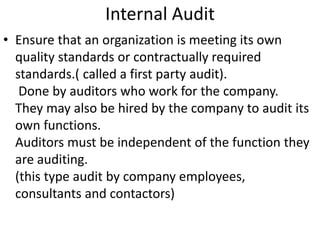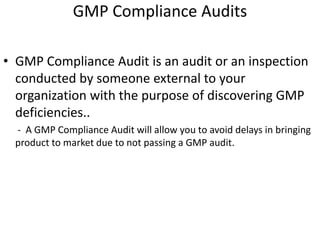Quality audit
- 1. Presentation on Audits Submitted To - Submitted By – Dr. Sanju Nanda Doninder Hooda M.Pharma 2nd sem DRA
- 2. Quality Audit Quality Audit is defined as a systematic and independent examination to determine whether quality activities and related results comply with planned arrangements, and whether these arrangements are implemented effectively and are suitable to achieve objectives
- 3. Types Of Quality Audit • The quality audit system mainly classified in following different categories:- 1. Internal Audit 2. External Audit 3. Second Party Audits 4. Third Party Audits 5. Process Audits 6. Product Audits 7. System Audits Main type
- 4. Internal Audit • Ensure that an organization is meeting its own quality standards or contractually required standards.( called a first party audit). Done by auditors who work for the company. They may also be hired by the company to audit its own functions. Auditors must be independent of the function they are auditing. (this type audit by company employees, consultants and contactors)
- 5. Purpose of Internal audit 1. To Ensure that adequate Quality systems are maintained. 2. To asses compliance with the C-GMP’s and firms standard operating procedure. 3. To achieve consistency between manufacturing and testing facilities. 4. To identify problems internally and Correct problems prior to a FDA inspection.
- 6. External Audits - External auditors are separate from the company. - They may be hired by a supplier or customer to ensure that the audited company meets their quality standards. - They may be audited by the government to verify that they meet military specifications. - External audits can be done by quality consultants specializing in the quality standards for those organizations.
- 7. Purpose of External Audit • - Confidence in the partnership arrangement. - Ensuring that requirements are understood. - Reducing the risk of failure. - Carried out by company on its vendors. - No legal requirement to conduct the audit. • -- External audit have experience of GMP as well as regularly audited by their certification body
- 8. • Second Party Audits- External audits done by a company that has a contract with the audited firm is called a second party audit. • Third Party Audits- External quality audits done by an organization that has no contract with the company it is auditing is called a third party audit.// • Process Audits- A process audit verifies that a documented process meets quality standards. This process could be a manufacturing process or service process.
- 9. • Product Audits- A product quality audit verifies that a physical product meets design specifications and other quality measurements. - measuring physical dimensions, product testing, or destructive testing, checking the calibration and test equipment used to verify that the product meets quality standards.. • System Audits- It is a review of how quality standards are measured and met by the company. It verifies the procedures used to measure the quality of the product, how defects are recorded, and how the company ensures that failed product is not passed.
- 10. GMP Compliance Audits • GMP Compliance Audit is an audit or an inspection conducted by someone external to your organization with the purpose of discovering GMP deficiencies.. - A GMP Compliance Audit will allow you to avoid delays in bringing product to market due to not passing a GMP audit.
- 11. • GMP compliance audit will allow you to: - Gain greater knowledge of the quality issues affecting your organization. -Develop increased awareness of regulatory expectations. • Recognize commonly seen GMP deficiencies and learn how to reduce them in your organization. • Understand the inspection process and how you can prepare for it. • Identify quality-critical areas in your own organization e.g. technical agreements, training, record keeping, delegation. • Receive guidance on changing legislation and increasing complexity in the manufacturing and distribution chain for medicinal products.
- 12. Audit Process
- 13. .
- 14. .
- 15. Auditing Strategies • Audits related to the organizational strategy can be divided into two distinct categories; strategic risk audits and strategy process audits. - Strategic risk audits focus on risks that are the result of pursuing certain strategically important organizational goals. - A strategy process audit is an assessment of the strategic management process or even of (the content of) the formulated strategy.
- 17. Audit Analysis
- 19. Preparation of Audit • Should start from the beginning of the study. • Ensure that we have the documents to prove that study has been conducted properly. • According to ICH-GCP, Local regulation, Institution SOP. • All party understand the protocol, procedure Any concern raised by any party should be documented. • Aware of the chronology of the event, version of documents.
- 20. Essential Documents • Study protocol, patient information sheet, informed consent, questionnaire, investigator brochure etc. Version, date submitted, approved, implemented . • Safety report : AE, SAE, SUSAR Submitted to EC, FDA . • Agreements : clinical, financial . • Study personnel : CV, authorised letter, sample of signature . • Enrollment log. • Correspondence
- 21. . • Case record form : CRF - Signed & dated informed consent - Completeness of CRF - Investigator signed & dated in the assigned pages - - Accuracy of data compared with source data - Black ball point pen - Logical date according to protocol ! - Source data has to be available
- 22. . • Source data :- - Patient note (OPD card) : should document the information required by the protocol (monitor can prepare the check list page & attach to the OPD card) - Other documents : lab test, ECG, X-rays, CT scan --- - Translator is required in case local language is not English (FDA inspection might ask for an independent translator)
- 23. . • Standardisation, maintenance of equipment Document to prove that all procedure is followed. • Logistics, accountability of the test kits, study medication- Temperature controlled required. • Study personnel who operate the machine- Well trained; training record, CV . • Sample handling procedure - Tissue block, blood, serum, etc























